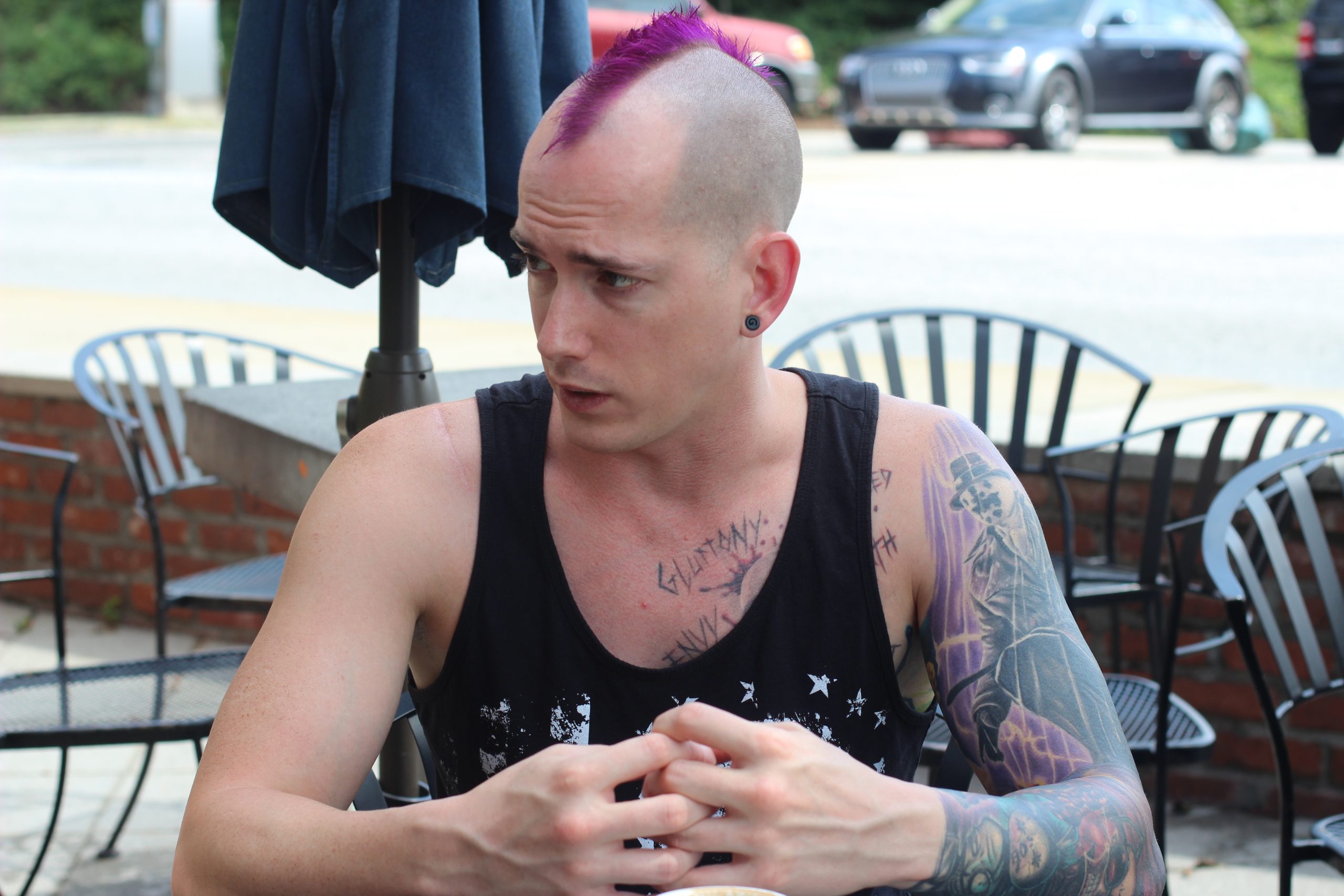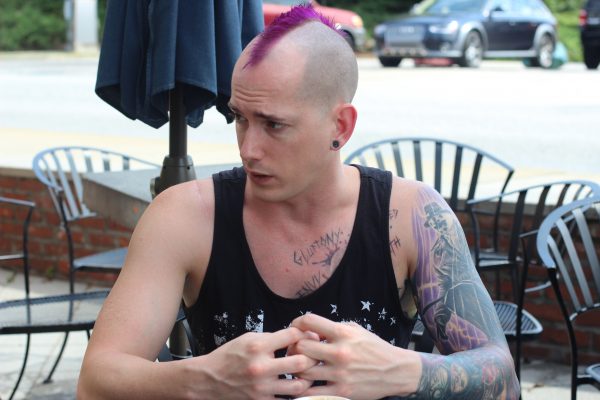

Photo by Brittany Guerin | The Signal
Georgia State students part of Professor Eric Wright’s sociology class banded together this summer scouring the streets of metro Atlanta with one goal in mind – to count the city’s marginalized homeless youth.
For four weeks, students traveled to shelters, extended stay hotels and some rough streets – like a high-crime area about a half-mile from the Georgia World Congress Center dubbed the “Bluffs.” They approached youth ages 14 to 25 to ask if they had an “adequate and safe place to stay.”
Chris Vidmar, Georgia State grad student and site leader, said the original estimate of homeless youth was in the low hundreds. But he said the students tallied more than 1000 youths without shelter in Atlanta and they’re still sifting through the data.
“We had started talking about this homeless youth count about a year and a half ago,” Wright said.
The miscalculations of how many homeless youth wander throughout Atlanta was part of the reason Wright and Georgia State decided to take matters into their own hands.
Piecing it all together
Wright, who redesigned and relaunched Indianapolis, Ind.’s homeless count in 2006, said Georgia State created the Domestic Field School within the sociology department to offer a chance for students to learn and gain hands-on experience in their own backyard.
The Atlanta Homeless Youth Count and Needs Assessment – the official name of the study – was the “kick-off” for the field school, according to Vidmar.
Georgia State senior, sociology major and participant Kara Tsukerman said students administered the survey from the middle of June to late July with a break on July 4.
Wright said the city of Atlanta, the county and 75 different organizations collaborated with Georgia State’s field school to put together the homeless count.
“[Georgia State is] the lead agency, and that’s partly because of all the politics around homelessness and the difficulties that some of the agencies and state agencies, city and county government have in terms of working together on these issues,” he said.
Everyone involved is committed to alleviating homelessness, but a lot of competition exists between agencies for funding, according to Wright.
Tsukerman said she loved the broad definition of homelessness the survey used, because it challenged what it means to be homeless.
“Most people, including me, prior to this, think of people who are unsheltered, who are sleeping outside,” she said. “But in our survey we included anyone who didn’t have a place of their own to stay. So even if they slept on their friend’s couch for a month, they counted.”
Tsukerman also said the word “homeless” was not used when talking to the youth, because it could be considered insulting.
“We approached people by saying, ‘We’re students from Georgia State and we’re out trying to find youth between the ages of 14 and 25 who don’t have a place of their own to stay, do you know anyone who falls in that category?’” she said.
Students were split into different groups to scatter throughout the city to cover as much ground as possible.
Vidmar said there were two data sweeps and each were held during a two-week time period.
In the first sweep students stuck to shelters but quickly realized they were missing large chunks of the city, according to Vidmar. For the second sweep he and two other site leaders deviated from the plan and led groups to extended stay hotels along I-285.
Ten dollar gift cards along with resource kits, which included information on where homeless youth could seek help, were given to those who took part in the survey, according to Tsukerman.
She said she never realized how youth homelessness is integrated into every corner of Atlanta.
“Some of the surveys were conducted in my neighborhood,” Tsukerman said. “I live right by the East Atlanta Village. I don’t think about homeless youth in my neighborhood. I look at people totally different. I feel like now all these people are visible to me who definitely used to be invisible.”
It’s more than just a count
Wright said every year Atlanta and cities across the nation are required by the federal government to conduct a Point-In-Time count.
“It’s a way they collect data on basic homeless statistics,” he said. “So every year in January, the city and counties do a count and send the numbers to Washington D.C. and the [federal government] compiles them in an annual report to Congress on the state of homelessness.”
Wright said the problem with previous surveys is they undercount unaccompanied youths.
Homeless advocate Marshall Rancifer attributed the misrepresentation to a group of people from outside of Atlanta who were brought in by the city to conduct the count last year.
“They missed more people last year during the count than they ever had before,” he said. “These folks had no clue about the city of Atlanta. They were just so unorganized.”
Rick Westbrook, executive director of Lost-n-Found, Atlanta’s only LGBT youth homeless shelter, said since the count was conducted at the shelter he has seen a boom in homeless youth walking through their doors. Typically volunteers see roughly 65 to 70 kids a month but now they’re seeing more than 300.
“We’re having to search for people just to staff the drop-in center, because there’s been so much going on,” he said. “I’ve even gone to, when we’re full, putting kids up at the Salvation Army.”
Vidmar also said homeless youth tend to avoid the chronically homeless.
“Actually a lot of the research shows that if there is older, chronic homelessness, generally homeless youth will not be in the same areas, because they’re more likely to be victimized by the chronically homeless,” he said.
Wright said the group of researchers purposefully tried to address the culture of homeless youth because of their separation from the older homeless.
“We incorporated a number of questions that really were designed to do a better job at exploring who these youth are,” he said. “The report is actually going to be both an estimate of the number of youth and also a description of who they are as people with a goal of really trying to provide a basis for a need assessment.”
A call to action
Wright said he hopes the data will rationalize the conversation, improve community interest in shaping new policies and develop new services for homeless youth.
“I’m a big believer in using research to help inform and shape policy and I’ve partnered a lot with politicians, state and local governments [and] community outreach organizations over my career to use science for best practices and best policies,” he said.
Vidmar said focusing on the city’s housing standards and affordability could help combat youth homelessness.
“A vast majority of this population isn’t homeless in the sense they are sleeping on a street,” he said. “They are homeless in the sense [that] they are paying $89 a week at an extended stay, because they can afford $350 a month to stay at an extended stay hotel. But they can’t afford $850 for an apartment.”
Vidmar also said he believes the city needs to address the problem for those who are on the brink of being chronically homeless, because they can’t pay their rent or don’t have a means to reach their job.
“If we’re going to have the kind of city where you can’t live in the city on minimum wage then we need to have the kind of city where you can live outside the city and pay your rent on minimum wage and get in the city on public transportation,” he said.
John Weber, spokesperson from Mayor Kasim Reed’s office, said in 2012 Reed launched Unsheltered No More, a program that “successfully housed more than 1000 homeless Atlantans.” Weber also said Reed announced this past May his push to end Veteran homelessness.
“The City of Atlanta does not have a specific initiative targeted at homeless youth,” Weber said. “Rather the COA, Continuum-of-Care seeks to provide support to homeless families and individuals.”
The count this summer is proof the issue is bigger than what people initially thought, according to Vidmar.
Wright said his immediate goal is to complete the report and provide it as a public document for “anyone interested in learning about who our homeless youth are in Atlanta.”
He said his long term goal is to use the report as pilot data to focus on additional research projects.
“[For example] I know a group of people who are interested in sex trafficking and sex work among this age population,” he said. “So that group, which will include myself, will go after pilot funding to study the problem more completely.”
Wright, Vidmar and Tsukerman expect to repeat the project next year, but nothing has been set in stone.
